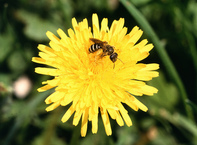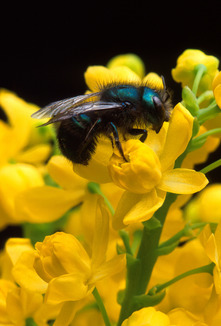|
Having trouble viewing this email? View it as a Web page.

|
|
|
Fresh from the
Field is a weekly album showcasing transformative impacts made by
partners supported by the National Institute of Food and Agriculture.
Editor: Falita Liles
June 21, 2018
|
|
Success Stories

Beyond
Honey Bees
Declines
in bee populations around the world have been widely reported over the past
several decades. Much attention has focused on honey bees, which commercial
beekeepers transport all over the United States to pollinate crops. Scientists
at Michigan State University (MSU) have made a complete assessment of native
and domesticated pollinators in the Great Lakes region. Their report may
provide answers in conservation and best management practices.
We
need bees for food security and to maintain healthy ecosystems. Bees pollinate
flowering trees and wildflowers, which in turn provide food and homes for other
animals and improve water, air, and soil quality.
Along
with honey bees, wild bees are also vital for crop pollination. Research has
shown that the presence of wild bees increases yields across many types of
crops. They often are more efficient at pollinating crops native to North
America than honey bees.
NIFA supports this
research through the Agriculture and Food Research Initiative.
Read the full story at MSU Today. USDA photo.
|
 UNH Researchers Find Drastic Decline in N.H.’s Bumble Bees
Researchers with the New
Hampshire Agricultural Experiment Station at the University of New Hampshire
(UNH) have found three of the state’s most important bumble bee species have
experienced drastic declines and range constriction over the last 150 years. A
fourth bee was in significant decline.
"Wild bees,
particularly bumble bees, are highly important pollinators for both agriculture
and unmanaged ecosystems. They have experienced alarming declines in recent
decades, and in order to effectively work towards their protection, information
about their life histories, ecological roles, and distributional changes on a
more local scale is needed," according to Sandra Rehan, assistant
professor of biological sciences at UNH.
NIFA supports this
research through Hatch Act Funds.
Read more at NIFA’s Blog.
|
 Bumble Bee Queens Under Pressure
Spring is a busy time for bumble bee
queens. After emerging from hibernation, their to-do list includes making
nests, laying eggs, and keeping their larvae warm and fed. It’s physiologically
demanding and the stakes are high: the success of the colony depends on a
queen’s solitary work during this time. Unlike honey bees, which are perennial,
bumble bee colonies arise each year from the work of a single queen to
establish a nest of up to 400 workers.
Researchers at the University of
California, Riverside found that environmental threats are piling onto the
stress faced by nest-building bumble bee queens. The team found that exposure
to a widely used insecticide and a poor diet negatively impacted bumble bee
queens’ health and work, which could have dramatic consequences on an already
dwindling pollinator group.
Bumble
bees are workhorses of the insect pollinator world, playing a key role in both
natural and agricultural ecosystems. Crops as diverse as tomato, blueberry, and
red clover all depend heavily on their pollination services. Bumble bees, which
are both fast and fuzzy, are highly efficient at transporting pollen from one
flower to another.
NIFA supports this research through Hatch Act Funds.
Read the full article
at UCR Today. Photo: USGS Bee Inventory.
|
Library
 Beekeeping in Rural and Urban Areas of
Ohio
Honey bees across the United States
are suffering as agricultural land is planted with crops less suitable for bees
at the expense of and bee-sustaining crops like alfalfa and clover. Heightened
interest in beekeeping has attracted new beekeepers, largely from urban areas.
Urban beekeepers suffer higher rates of colony loss than their rural
counterparts, which may be due to their inexperience or other factors in the
urban landscape, such as toxic exposure or differences in flower availability.
Ohio State University entomologists,
in cooperation with the Ohio State Beekeepers Association, compared flowers
used by urban bees to flowers typically available in rural areas. They studied new
beekeepers in urban, suburban, and rural Ohio to track colony productivity; colonies
produced less honey as the landscape became more urban. Urban bees are less
productive, likely due to a lack of flowers in Ohio cities in late-summer and
fall.
Researchers also collected pollen
from bees in urban and rural locations to identify which plants the bees visit
in the late-summer and fall. Observation hives were placed on the edge of
Columbus, Ohio, to determine whether bees would choose to forage in the
suburban area or in the nearby corn and soybean fields outside of the city.
When given a choice, honey bees forage on clover and goldenrod that are
abundant in agricultural areas and avoid foraging in urban locations.
Honey bees and other pollinators are
vital for the local production of fruits and vegetables as well as locally
produced honey. As urbanization continues, expanding the urban bee-keeping
market may be the key to honeybee survival. Encouraging cities to plant clovers
and goldenrods will provide a greater source of pollen in the late-summer and
fall, when forage is otherwise limited. Supportive plantings will increase the
honey crop for beekeepers and provide honey bee colonies with the nutrition
they need to prepare for and survive the winter season. Additionally, new
education programs can help new improve colony success.
Providing foraging areas for
pollinators will increase the number of pollinators in urban and suburban
areas, which in turn increases the income of beekeepers. Since bees pollinate a
large number of flowers and agricultural crops, it is expected that an increase
in the bee population would lead to more successful farmers as well.
NIFA supports this research through Multistate Research Funds.
Read more at the Land-Grants Impact
Database. USDA photo.
|
Tweet of the Week
#NIFAIMPACTS

|
|

NIFA’s mission is to invest in and advance agricultural research, education, and extension that solve societal challenges. NIFA’s investments in transformative science directly support the long-term prosperity and global preeminence of U.S. agriculture. To learn more about NIFA’s impact on agricultural sciences, visit www.nifa.usda.gov/Impacts, sign up for email updates or follow us on Twitter @USDA_NIFA, #NIFAImpacts.
USDA is an equal opportunity lender, provider, and employer.
|
|